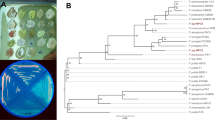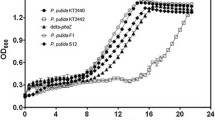Abstract
Economical production of medium-chain length polyhydroxyalkanoates (mcl-PHA) is dependent on efficient cultivation processes. This work describes growth and mcl-PHA synthesis characteristics of Pseudomonas putida LS46 when grown on medium-chain length fatty acids (octanoic acid) and lower-cost long-chain fatty acids (LCFAs, derived from hydrolyzed canola oil) in microaerophilic environments. Growth on octanoic acid ceased when the oxygen uptake rate was limited by the oxygen transfer rate, and mcl-PHA accumulated to 61.9% of the cell dry mass. From LCFAs, production of non-PHA cell mass continued at a rate of 0.36 g L−1 h−1 under oxygen-limited conditions, while mcl-PHA accumulated simultaneously to 31% of the cell dry mass. The titer of non-PHA cell mass from LCFAs at 14 h post-inoculation was double that obtained from octanoic acid in bioreactors operated with identical feeding and aeration conditions. While the productivity for octanoic acid was higher by 14 h, prolonged cultivation on LCFAs achieved similar productivity but with twice the PHA titer. Simultaneous co-feeding of each substrate demonstrated the continued cell growth under microaerophilic conditions characteristic of LCFAs, and the resulting polymer was dominant in C8 monomers. Furthermore, co-feeding resulted in improved PHA titer and volumetric productivity compared to either substrate individually. These results suggest that LCFAs improve growth of P. putida in oxygen-limited environments and could reduce production costs since more non-PHA cell mass, the cellular factories required to produce mcl-PHA and the most oxygen-intensive cellular process, can be produced for a given oxygen transfer rate.







Similar content being viewed by others
References
Anderson AJ, Dawes EA (1990) Occurrence, metabolism, metabolic role, and industrial uses of bacterial polyhydroxyalkanoates. Microbiol Rev 54:450–472 doi: 0.146–0749/90/040450–23$02.00/0
Andin N, Longieras A, Veronese T, Marcato F, Molina-Jouve C, Uribelarrea JL (2017) Improving carbon and energy distribution by coupling growth and medium chain length polyhydroxyalkanoate production from fatty acids by Pseudomonas putida KT2440. Biotechnol Bioprocess Eng 22:308–318. https://doi.org/10.1007/s12257-016-0449-1
Anjum A, Zuber M, Zia KM, Noreen A, Anjum MN, Tabasum S (2016) Microbial production of polyhydroxyalkanoates (PHAs) and its copolymers: a review of recent advancements. Int J Biol Macromol 89:161–174. https://doi.org/10.1016/j.ijbiomac.2016.04.069
Blunt W, Hossain ME, Gapes D, Sparling R, Levin DB, Cicek N (2014) Real-time monitoring of microbial fermentation end-products in biofuel production with titrimetric off-gas analysis (TOGA). Biol Eng Trans 6:203–219. https://doi.org/10.13031/bet.6.10496
Blunt W, Dartiailh C, Sparling R, Gapes D, Levin DB, Cicek N (2017) Microaerophilic environments improve the productivity of medium chain length polyhydroxyalkanoate biosynthesis from fatty acids in Pseudomonas putida LS46. Process Biochem 59:18–25. https://doi.org/10.1016/j.procbio.2017.04.028
Brandl H, Gross RA, Lenz RW, Fuller RC (1988) Pseudomonas oleovorans as a source for novel poly(beta-hydroxyalkanoates). Appl Environ Microbiol 54:1977–1982
Chanprateep S (2010) Current trends in biodegradable polyhydroxyalkanoates. J Biosci Bioeng 110:621–632. https://doi.org/10.1016/j.jbiosc.2010.07.014
Chhetri AB, Watts KC, Islam MR (2008) Waste cooking oil as an alternate feedstock for biodiesel production. Energies 1:3–18. https://doi.org/10.3390/en1010003
Choi J II, Lee SY (1997) Process analysis and economic evaluation for poly(3-hydroxybutyrate) production by fermentation. Bioprocess Eng 17:335–342. https://doi.org/10.1007/s004490050394
Choi JI, Lee SY (1999) High-level production of poly(3-hydroxybutyrate-co-3-hydroxyvalerate) by fed-batch culture of recombinant Escherichia coli. Appl Environ Microbiol 65:4363–4368
Davis R, Duane G, Kenny ST, Cerrone F, Guzik MW, Babu RP, Casey E, O’Connor KE (2015) High cell density cultivation of Pseudomonas putida KT2440 using glucose without the need for oxygen enriched air supply. Biotechnol Bioeng 112:725–733. https://doi.org/10.1002/bit.25474
de Waard P, van der Wal H, Huijberts GN, Eggink G (1993) Heteronuclear NMR analysis of unsaturated fatty acids in poly(3-hydroxyalkanoates). Study of beta-oxidation in Pseudomonas putida. J Biol Chem 268:315–319
Desbois AP, Smith VJ (2010) Antibacterial free fatty acids: activities, mechanisms of action and biotechnological potential. Appl Microbiol Biotechnol 85:1629–1642. https://doi.org/10.1007/s00253-009-2355-3
Dirusso CC, Black PN (2004) Bacterial long chain fatty acid transport: gateway to a fatty acid-responsive signaling system. J Biol Chem 279:49563–49566. https://doi.org/10.1074/jbc.R400026200
Du C, Sabirova J, Soetaert W, Ki Carol Lin S (2012) Polyhydroxyalkanoates production from low-cost sustainable raw materials. Curr Chem Biol 6:14–25. https://doi.org/10.2174/187231312799984394
Dufresne A, Reche L, Marchessault RH, Lacroix M (2001) Gamma-ray crosslinking of poly(3-hydroxyoctanoate-co-undecenoate). Int J Biol Macromol 29:73–82. https://doi.org/10.1016/S0141-8130(01)00152-0
Elbahloul Y, Steinbüchel A (2009) Large-scale production of poly(3-hydroxyoctanoic acid) by Pseudomonas putida GPo1 and a simplified downstream process. Appl Environ Microbiol 75:643–651. https://doi.org/10.1128/AEM.01869-08
Fernández D, Rodríguez E, Bassas M, Viñas M, Solanas AM, Llorens J, Marqués AM, Manresa A (2005) Agro-industrial oily wastes as substrates for PHA production by the new strain Pseudomonas aeruginosa NCIB 40045: effect of culture conditions. Biochem Eng J 26:159–167. https://doi.org/10.1016/j.bej.2005.04.022
Fonseca P, de la Peña F, Prieto MA (2014) A role for the regulator PsrA in the polyhydroxyalkanoate metabolism of Pseudomonas putida KT2440. Int J Biol Macromol 71:14–20. https://doi.org/10.1016/j.ijbiomac.2014.04.014
Fontaine P, Mosrati R, Corroler D (2017) Medium chain length polyhydroxyalkanoates biosynthesis in Pseudomonas putida mt-2 is enhanced by co-metabolism of glycerol/octanoate or fatty acids mixtures. Int J Biol Macromol 98:430–435. https://doi.org/10.1016/j.ijbiomac.2017.01.115
Fu J, Sharma U, Sparling R, Cicek N, Levin DB (2014) Evaluation of medium-chain-length polyhydroxyalkanoate production by Pseudomonas putida LS46 using biodiesel by-product streams. Can J Microbiol 60:461–468. https://doi.org/10.1139/cjm-2014-0108
Fujita Y, Matsuoka H, Hirooka K (2007) Regulation of fatty acid metabolism in bacteria. Mol Microbiol 66:829–839. https://doi.org/10.1111/j.1365-2958.2007.05947.x
Garcia-Ochoa F, Gomez E, Santos VE, Merchuk JC (2010) Oxygen uptake rate in microbial processes: an overview. Biochem Eng J 49:289–307. https://doi.org/10.1016/j.bej.2010.01.011
Grousseau E, Blanchet E, Déléris S, Albuquerque MGE, Paul E, Uribelarrea JL (2013) Impact of sustaining a controlled residual growth on polyhydroxybutyrate yield and production kinetics in Cupriavidus necator. Bioresour Technol 148:30–38. https://doi.org/10.1016/j.biortech.2013.08.120
Guedon E, Payot S, Desvaux M, Petitdemange H (1999) Carbon and electron flow in Clostridium cellulolyticum grown in chemostat culture on synthetic medium. J Bacteriol 181:3262–3269
Haba E, Vidal-Mas J, Bassas M, Espuny MJ, Llorens J, Manresa A (2007) Poly 3-(hydroxyalkanoates) produced from oily substrates by Pseudomonas aeruginosa 47T2 (NCBIM 40044): effect of nutrients and incubation temperature on polymer composition. Biochem Eng J 35:99–106. https://doi.org/10.1016/j.bej.2006.11.021
Hartmann R, Hany R, Pletscher E, Ritter A, Witholt B, Zinn M (2006) Tailor-made olefinic medium-chain-length poly[(R)-3-hydroxyalkanoates] by Pseudomonas putida GPo1: batch versus chemostat production. Biotechnol Bioeng 93:737–746. https://doi.org/10.1002/bit.20756
Huijberts GNM, Eggink G, De Waard P, Huisman GW, Witholt B (1992) Pseudomonas putida KT2442 cultivated on glucose accumulates poly(3- hydroxyalkanoates) consisting of saturated and unsaturated monomers. Appl Environ Microbiol 58:536–544
Jarboe LR, Royce LA, Liu P (2013) Understanding biocatalyst inhibition by carboxylic acids. Front Microbiol 4:1–8. https://doi.org/10.3389/fmicb.2013.00272
Jiang X, Sun Z, Marchessault RH, Ramsay JA, Ramsay BA (2012) Biosynthesis and properties of medium-chain-length polyhydroxyalkanoates with enriched content of the dominant monomer. Biomacromolecules 13:2926–2932. https://doi.org/10.1021/bm3009507
Kang Y, Nguyen DT, Son MS, Hoang TT (2008) The Pseudomonas aeruginosa PsrA responds to long-chain fatty acid signals to regulate the fadBA5 β-oxidation operon. Microbiology 154:1584–1598. https://doi.org/10.1099/mic.0.2008/018135-0
Kaur G, Roy I (2015) Strategies for large-scale production of polyhydroxyalkanoates. Chem Biochem Eng Q 29:157–172. https://doi.org/10.15255/CABEQ.2014.2255
Kellerhals MB, Kessler B, Witholt B, Tchouboukov A, Brandl H (2000) Renewable long-chain fatty acids for production of biodegradable medium-chain-length polyhydroxyalkanoates (mcl-PHAs) at laboratory and pilot plant scales. Macromolecules 33:4690–4698. https://doi.org/10.1021/ma000655k
Kim GJ, Lee IY, Yoon SC, Shin YC, Park YH (1997) Enhanced yield and a high production of medium-chain-length poly(3-hydroxyalkanoates) in a two-step fed-batch cultivation of Pseudomonas putida by combined use of glucose and octanoate. Enzym Microb Technol 20:500–505. https://doi.org/10.1016/S0141-0229(96)00179-2
Koller M, Maršálek L, de Sousa Dias MM, Braunegg G (2017) Producing microbial polyhydroxyalkanoate (PHA) biopolyesters in a sustainable manner. New Biotechnol 37:24–38. https://doi.org/10.1016/j.nbt.2016.05.001
Kourmentza C, Plácido J, Venetsaneas N, Burniol-Figols A, Varrone C, Gavala HN, Reis MAM (2017) Recent advances and challenges towards sustainable Polyhydroxyalkanoate (PHA) production. Bioengineering 4:1–43. https://doi.org/10.3390/bioengineering4020055
Kurth N, Brachet F, Robic D, Bourbouze R, Renard E, Guerin P (2001) Poly(3-hydroxyoctanoate) containing pendant carboxylic groups for the preparation of nanoparticles aimed at drug transport and release. Polymer (Guildf) 43:1095–1101. https://doi.org/10.1016/S0032-3861(01)00692-9
Lara AR, Galindo E, Ramírez OT, Palomares LA (2006) Living with heterogeneities in bioreactors: understanding the effects of environmental gradients on cells. Mol Biotechnol 34:355–382. https://doi.org/10.1385/MB:34:3:355
Lee SY, Wong HH, Il CJ, Lee SH, Lee SC, Han CS (2000) Production of medium-chain-length polyhydroxyalkanoates by high-cell- density cultivation Pseudomonas putida under phosphorus limitation. Biotechnol Bioeng 68:466–470. https://doi.org/10.1002/(SICI)1097-0290(20000520)68:4<466::AID-BIT12>3.0.CO;2-T
López NI, Pettinari MJ, Nikel PI, Méndez BS (2015) Polyhydroxyalkanoates: Much More than Biodegradable Plastics. Adv Appl Microbiol 93:73–106. https://doi.org/10.1016/bs.aambs.2015.06.001
Maclean H, Sun Z, Ramsay J, Ramsay B (2008) Decaying exponential feeding of nonanoic acid for the production of medium-chain-length poly (3-hydroxyalkanoates) by Pseudomonas putida. Can J Chem 86:564–569. https://doi.org/10.1139/V08-062
Mozejko J, Ciesielski S (2014) Pulsed feeding strategy is more favorable to medium-chain-length polyhydroxyalkanoates production from waste rapeseed oil. Biotechnol Prog 30:1243–1246. https://doi.org/10.1002/btpr.1914
Możejko-Ciesielska J, Kiewisz R (2016) Bacterial polyhydroxyalkanoates: still fabulous? Microbiol Res 192:271–282. https://doi.org/10.1016/j.micres.2016.07.010
Nikel PI, de Lorenzo V (2013) Engineering an anaerobic metabolic regime in Pseudomonas putida KT2440 for the anoxic biodegradation of 1,3-dichloroprop-1-ene. Metab Eng 15:98–112. https://doi.org/10.1016/j.ymben.2012.09.006
Nikodinovic-Runic J, Guzik M, Kenny ST, Babu R, Werker A, O’Connor KE (2013) Carbon-rich wastes as feedstocks for biodegradable polymer (polyhydroxyalkanoate) production using bacteria. Adv Appl Microbiol 84:139–200. https://doi.org/10.1016/B978-0-12-407673-0.00004-7
Ramsay BA, Lomaliza K, Chavarie C, Dube B, Bataille P, Ramsay JA (1990) Production of poly-(P-hydroxybutyric-Co-3-Hydroxyvaleric ) acids. Appl Environ Microbiol 56:2093–2098
Ravindran R, Jaiswal AK (2016) Exploitation of food industry waste for high-value products. Trends Biotechnol 34:58–69. https://doi.org/10.1016/j.tibtech.2015.10.008
Ren Q, de Roo G, Ruth K, Witholt B, Zinn M, Thöny-Meyer L (2009) Simultaneous accumulation and degradation of polyhydroxyalkanoates: futile cycle or clever regulation? Biomacromolecules 10(4):916–922
Sharma PK, Fu J, Cicek N, Sparling R, Levin DB (2012) Kinetics of medium-chain-length polyhydroxyalkanoate production by a novel isolate of Pseudomonas putida LS46. Can J Microbiol 58:982–989. https://doi.org/10.1139/w2012-074
Sohn SB, Kim TY, Park JM, Lee SY (2010) In silico genome-scale metabolic analysis of Pseudomonas putida KT2440 for polyhydroxyalkanoate synthesis, degradation of aromatics and anaerobic survival. Biotechnol J 5:739–750. https://doi.org/10.1002/biot.201000124
Song JH, Jeon CO, Choi MH, Yoon SC, Park W (2008) Polyhydroxyalkanoate (PHA) production using waste vegetable oil by. J Microbiol Biotechnol 18:1408–1415
Sun Z, Ramsay JA, Guay M, Ramsay BA (2007) Fermentation process development for the production of medium-chain-length poly-3-hyroxyalkanoates. Appl Microbiol Biotechnol 75:475–485. https://doi.org/10.1007/s00253-007-0857-4
Vendruscolo F, Rossi MJ, Schmidell W, Ninow JL (2012) Determination of oxygen solubility in liquid media. ISRN Chem Eng 2012:1–5. https://doi.org/10.5402/2012/601458
Wallace T, Gibbons D, O’Dwyer M, Curran TP (2017) International evolution of fat, oil and grease (FOG) waste management—a review. J Environ Manag 187:424–435. https://doi.org/10.1016/j.jenvman.2016.11.003
Wang F, Lee SY (1997) Poly(3-Hydroxybutyrate ) production with high productivity and high polymer content by a fed-batch culture of Alcaligenes latus under nitrogen limitation. Appl Environ Microbiol 63:3703–3706. https://doi.org/10.1023/a:1012222625201
Funding
This study was funded by the Genome Canada, through the Genome Applications and Partnership Program (GAPP), and the Natural Sciences and Engineering Research Council (NSERC) of Canada through a Collaborative Research and Development (CRD) grant with Minto BioProducts Ltd. as the industrial partner (grant number CRDPJ-490630-15).
Author information
Authors and Affiliations
Corresponding author
Ethics declarations
Conflict of interest
The authors declare they have no conflict of interest.
Ethical approval
This article does not contain any studies with human participants or animals performed by any of the authors.
Rights and permissions
About this article
Cite this article
Blunt, W., Dartiailh, C., Sparling, R. et al. Carbon flux to growth or polyhydroxyalkanoate synthesis under microaerophilic conditions is affected by fatty acid chain-length in Pseudomonas putida LS46. Appl Microbiol Biotechnol 102, 6437–6449 (2018). https://doi.org/10.1007/s00253-018-9055-9
Received:
Accepted:
Published:
Issue Date:
DOI: https://doi.org/10.1007/s00253-018-9055-9




